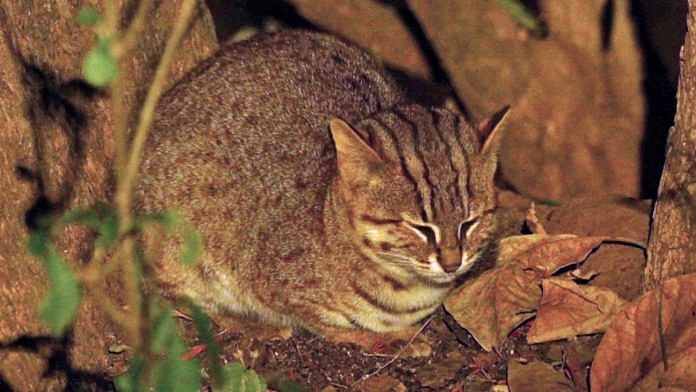New Delhi: For the first time ever, the elusive rusty-spotted cat was found frolicking in the jungles of West Bengal’s Purulia district. Researchers spotted it while searching for pangolin poachers in the forest patch located in the easternmost area of the Chota Nagpur Plateau.
It is the world’s smallest and lightest known cat.
Weighing a mere 900 grams, it appeared in front of one of the seven camera traps installed in the forest by the Human and Environment Alliance League (HEAL)—a Kolkata-based non-profit working on wildlife conservation projects in the area—and the Duleep Matthai Nature Conservation Trust on 12 January.
The rusty-spotted cat is only found in India and Sri Lanka, and was only recently discovered in the forests of Nepal. India holds 80 percent of the cat’s total population, with a major portion of its habitat at risk of land conversion. Spotting the cat in the wild is extremely difficult, owing not only to its quiet prowls through the jungle but also its small size.
The discovery of the cat in this geographical area has excited conservationists and forest officials alike.
“We set up the camera traps on 1 January and spotted the cat on 12 January. We don’t know if a local population of the species has thrived in the forest or if the cat spotted by the camera is just a migrant in the area,” Suvrajyoti Chatterjee, secretary of HEAL, told ThePrint over the phone.
The rusty-spotted cat is typically found in the jungles of Chhattisgarh, Odisha, and Jharkhand, and thrives in dry, deciduous forests. Chatterjee says that a satellite view of the Chota Nagpur Plateau shows the forests are interconnected, and the animal might have migrated to the region. However, it remains under threat.
“This patch of Purulia forest sees a lot of hunting by the local communities, who often venture into the forest. We were looking for pangolin poachers for our project when we spotted the cat. These forests are not even protected forests but reserved ones,” Chatterjee added.
Divisional Forest Officer Anjan Guha, in the meantime, declared that the discovery of the animal in West Bengal’s forests highlights the spectacular work done by the government regarding conservation.
“Qualitatively, we have improved the forest areas in Purulia, and the spotting of a rare animal illustrates our efforts. It is an example of the coexistence of wildlife, and West Bengal is setting an example,” Guha told ThePrint.
A thriving forest
The cat meandering through the forests of Purulia is not exactly surprising, according to conservationists. The landscape of the area is favourable to the animal, and it can be spotted in neighbouring forests.
“The cat is just one and a half feet long, with its tail being one foot long itself. It is smaller than a domestic cat, and a kitten of this species weighs less than a poultry egg,” Tiasa Adhya, director of ecology and conservation programmes at HEAL, told ThePrint.
Chatterjee added that since Covid, the patch in Purulia forests has been thriving due to increased surveillance, as disturbances to the ecosystem have declined ever since. In 2022, a leopard was spotted in the area, which led to widespread panic, and villagers stopped taking their livestock for grazing inside. This, he believes, has helped mammals, birds, and other wildlife thrive.
In the forests of Purulia, leopards are the apex predators, sitting at the top of the food chain. Other carnivores in these forests include bears, jackals, and foxes.
A leopard was also killed in a surrounding area last year after it attacked the villagers’ livestock. HEAL has since started a livestock programme to support villagers and dissuade them from attacking wild animals in future.
“We have started a livestock support programme for the villagers, where we replace any livestock they lose to carnivores. Not just leopards, other animals such as jackals also prey on small goats. Such a programme helps villagers tolerate the loss of animals,” Adhya added.
Adhya believes that for wildlife to thrive in the area, a habitat-scale approach is needed where the villagers don’t see their neighbours—the animals—as enemies but rather as friends. And a cute little cat will probably be the easiest to befriend.
(Edited by Radifah Kabir)
Also Read: Meow to you too: Cats know when their human is talking to them, finds French study






